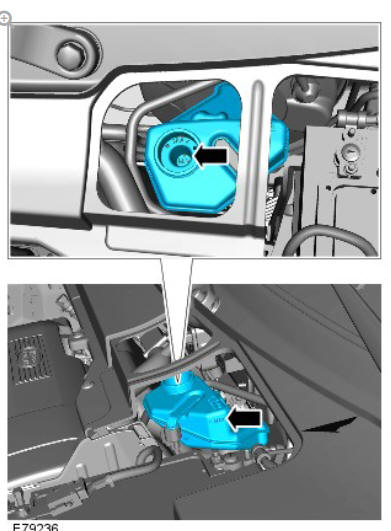Land Rover Discovery: General Information Brake System Pressure Bleeding (G1785101) / General Procedures
BLEEDING
NOTE:
Some variation in the illustrations may occur, but the essential information is always correct.
All vehicles
WARNING:
Make sure to support the vehicle with axle stands.
Raise and support the vehicle.
Check that the brake fluid lines are secure and that there are no signs of a brake fluid leak. If a brake fluid leak is detected, investigate and rectify the cause of the leak before bleeding the brakes.
Right-hand drive vehicles
.jpg)
Left-hand drive vehicles
.jpg)
All vehicles
CAUTION:
LH illustration shown, RH is similar.
.jpg)
Remove the brake fluid reservoir cap.
WARNING:
Do not allow dirt or foreign liquids to enter the reservoir. Use only new brake fluid of the correct specification from airtight containers. Do not mix brands of brake fluid as they may not be compatible.
CAUTIONS:
- Brake fluid will damage paint finished surfaces. If spilled, immediately remove the fluid and clean the area with water.
- The brake fluid reservoir must remain full with new, clean brake fluid at all times during bleeding.
- LH illustration shown, RH is similar.
.jpg)
Fill the brake fluid reservoir to the MAX mark.
Conduct the bleed procedure with the engine running.
Install the bleed tube to the brake caliper bleed screw and immerse the free end of the bleed tube in a bleed jar containing a small quantity of approved brake fluid.
Left-hand drive vehicles
.jpg)
Starting at the brake caliper furthest away from the brake master cylinder, loosen the bleed screw by one-half to three-quarters of a turn.
Right-hand drive vehicles
.gif)
All vehicles
CAUTION:
The brake fluid reservoir must remain full with new, clean brake fluid at all times during bleeding.
With assistance, depress the brake pedal steadily through to 2/3 of its full stroke.
With the brake pedal held down, close bleed screw and then return the brake pedal to 1/3 of its full stroke and hold.
Repeat steps 7 and 8, 28 times for the rear brake and 10 times for the front brake.
At the end of the bleed process, depress and hold the brake pedal down.
CAUTION:
Make sure the bleed screw cap is installed after bleeding.
This will prevent corrosion to the bleed screw.
With the brake pedal fully depressed, tighten the bleed screw.
Torque:
Front bleed screw 15 Nm
Rear bleed screw 15 Nm
CAUTION:
LH illustration shown, RH is similar.

Fill the brake fluid reservoir to the MAX mark.
WARNING:
Braking efficiency may be seriously impaired if an incorrect bleed sequence is used.
Repeat the brake bleeding procedure for each brake caliper, following the above sequence.
CAUTION:
LH illustration shown, RH is similar.
.jpg)
Install the brake fluid reservoir cap.
Apply the brakes and check for leaks.
Right-hand drive vehicles
.jpg)
Left-hand drive vehicles
.jpg)

